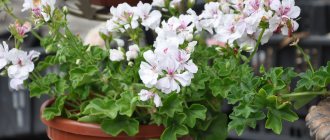How to choose a bacopa variety?
In nature, sutera grows in subtropical and tropical climates near lakes, rivers and swamps. Its stem quickly creeps along the ground and grows into new territories. In its original form, bacopa had only white flowers. However, over time, breeders have developed numerous variations: with different shades, large inflorescences, and double flowers.
Sutera blooms profusely throughout the summer and until mid-autumn. Even after rain, the inflorescences do not fall off and the plant does not lose its attractive appearance.
To choose the right sutera variety, you need to focus on the conditions in which the flower will be located. For example, plants with large or double flowers are more capricious than ordinary varieties. Therefore, to design vertical compositions, it is better to use unpretentious plants, since such bacopa has long shoots that will look beautiful even with traditional white flowers.
For decorating ponds or aquariums, the preferred variety is “Karolinska” or “Monier”. The first plant grows up to 30-40 cm. Bacopa “Carolinska” can grow even under water. Its stems smell like lemon when crushed and bloom with blue or blue flowers throughout the summer.
Bacopa Carolinica
The Monier variety is characterized by blue, white or pink flowers.
Varieties “Snowtopia” with white inflorescences and “Blutopia” - with blue ones are often used to decorate balconies, terraces and other open areas. Sutera varieties Snowflake and Cabana are showered with many large flowers in shades of pink, white or purple.
Sutera "Giant Snowflake" is a large variety with a long stem - 90 cm. It has small leaves and large white flowers. The bush is densely covered with snow-white inflorescences, falling in the form of a waterfall. This plant looks ideal in hanging pots or vertical compositions.
Sutera “Giant Snowflake”
For Bacopa "Olympic Gold" the distinctive feature is the golden hue of the leaves. They are complemented by snow-white flowers of medium size.
Suter flowers go well with fuchsias, nasturtiums, chrysanthemums and petunias. It is often used in flower beds and alpine hills as a ground cover. Bacopa grows well and forms a continuous carpet. In landscape design, it is used both as the main plant and to create a background.
Combination of bacopa with petunia
Also, original bouquets are made from sutera. This composition can maintain a fresh look for a long time.
Botanical description
Bacopa (lat. Bacopa) is a creeping perennial plant of the Plantain family. The genus includes about 70 species , among which are succulents, as well as aquatic and water-loving suters.
Under natural conditions, bacopa grows as an aquatic plant in southern Africa and the Canary Islands, and is also found in Asian countries.
The ampelous variety is grown as a decorative decoration for garden plots, loggias and terraces.
Botanical description:
- the plant has lanceolate, small leaves, solid in structure;
- creeping shoots, up to 50-60 cm long;
- the flowers are small, with five petals, at the edges they can be simple or double;
- The color of the petals is most often white, less often purple or pink.
The flower tolerates any natural disasters well - extreme heat, prolonged showers and winds - and retains its decorative value.
Sutera blooms very profusely, so the people of Great Britain gave it the name “snow flakes”. At night, the flowers close.
Planting bacopa
Bacopa is grown mainly by seedlings. The best time for growing is early March. You can sow seeds in February, but then you should provide an additional source of lighting.
Important! When choosing seeds, pay attention to their expiration date. Germination remains only for 3 years.
Good soil for planting sutera must meet the following requirements:
- loose, wet;
- with low acidity;
- must contain a mixture of peat and soil in equal proportions;
- processed by heat in the oven at a temperature of 80-90°C for 4 hours.
It is also recommended to add wet compost to the soil. When planting in vertical and suspended structures, the soil should be supplemented with humus and sand.
Pots with seedlings
Flower pots are placed on the sunny side, otherwise the bushes will begin to grow in length in the shade. The best option is a sunny area, shaded on a hot afternoon.
In the aquarium, the plant is illuminated with a fluorescent lamp, and sand or small pebbles are used as soil.
Successful options for bacopa in landscape design
Ampelous bacopa flower - white, blue, double and spreading varieties
When decorating a garden, there are many options for planting bacopa. You can try growing it as a ground cover plant, giving it a small lawn next to roses or chrysanthemums. Interesting solutions are when this flower is used to decorate arches, terraces, and create vertical flowering walls.
Note! Bacopa looks charming when planted in wicker baskets placed directly on the lawn. It looks like someone left a basket of flowers on the grass.
You can use a flowerpot with this plant to decorate a pond or fountain. Bacopa loves high humidity, so if it is provided with enough light and nutrition, it will turn an ordinary pond into a beautiful romantic corner.
Agrotechnical subtleties of growing bacopa
For successful cultivation, it is necessary to strictly fulfill the conditions for preparing the optimal location, soil quality and ensuring proper care:
- A drainage layer of fine crushed stone or river sand is poured into the planting pot, which prevents moisture from stagnating. Drainage prevents root rot and other diseases.
- Before planting, it is advisable to soak the seed material for 30 minutes in a solution of potassium permanganate.
- The seeds are sown superficially, not covered with soil, but only lightly compacted.
- The pot with seeds is covered with glass and set aside in a warm, bright place, ensuring the soil is moistened and ventilated.
- The room temperature should be around 20°C.
- After 2-3 weeks, the first shoots sprout. After this, the glass can be removed and the dense shoots thinned out.
- For successful growth, it is necessary that the soil maintains moisture and the sprouts receive nutrients.
- The first feeding is carried out 2 weeks after the sprouts appear. Then repeat every 12-15 days. Feeding should include phosphorus, nitrogen and potassium.
- The seedlings should be watered carefully, drop by drop, without allowing the soil to dry out. An abundance of moisture is also undesirable, as it can lead to rotting of the roots.
- When 3-4 leaves appear, it is time for the first picking. When replanting, the natural soil layer should be preserved.
- The pick is performed a second time at a permanent location. Strong bushes are planted, deepening them into the ground. This procedure will allow the development of additional roots, which in the future will give good rooting and ensure abundant flowering.
- Seedlings are planted at a distance of at least 10 cm between sprouts.
On a note! For planting, it is better to take transparent containers, in which it is easier to control the soil moisture.
In the second year of life, it is recommended to renew bacopa by separating cuttings from it for subsequent rooting.
Bacopa seedlings
Cuttings can be prepared from February to April or at the end of summer. Sprouts are obtained from an adult bacopa plant. A full-fledged cutting must have at least two internodes. The leaves are removed from the lower node and the plant is placed in water or a moist soil substrate. The fluid should be changed daily. After approximately 18 days, the sprouts are planted in the ground according to the seedling principle. To make the plant lush and beautiful, you should immediately pinch the top of the shoot.
Reproduction
In addition to the seed propagation method, there is another one - the process of cuttings. To do this, it is necessary to use small remnants of shoots, the length of which is about 15 cm.
Garden hibiscus - types, description, planting, care and propagation + 69 photos- Celosia - growing from seeds and seedlings, planting in the ground and care rules + 80 photos
Clematis - general information, cultivation, planting conditions, care and reproduction + 88 photos
After this, they are placed on a moistened area of soil for dense rooting. Axillary roots quickly grow to the ground, thereby ensuring good fixation of bacopa.
After some time, you can observe a dense cover of this plant. The optimal period of time for harvesting cuttings is considered to be the beginning of January or the end of March.
Transplantation into open ground
Before planting in open ground, sprouts should be prepared in advance for low temperatures. To do this, the seedlings are periodically placed in cooler conditions, gradually raising the temperature to 15°C. After hardening, young plants can be planted in the ground in the second half of May.
Seedlings in open ground
Bacopa will grow best in moist soil in light partial shade. When planting seedlings, you should maintain an interval between bushes of at least 20 cm.
If the temperature drops below 10°C, the sprouts should be covered with film.
Care
Caring for bacopa depends on its growing conditions, as well as the variety. Next, we will give detailed instructions on the maintenance of indoor specimens.
Lighting
The flower is not picky about the presence of sun and feels comfortable in the shade. But you should know that the decorative qualities of the plant depend on the location of the pot . For rapid growth and lush flowering, sutera will need a well-lit place.
If there is no lighting at all, the plant may die.
Temperature
During the period of active growth, the flower will require a normal room temperature of 20-25 degrees.
Bacopa bushes are frost-resistant and can tolerate temperatures as low as -5 degrees. In addition, the plant is not afraid of sudden changes and is excellent for planting in open ground. With the onset of cold weather, it is better to place an indoor flower on the balcony, and the thermometer reading should not exceed +15 degrees.
Humidity and watering
When watering the sutera, you should be guided by the rule: the earthen ball should not dry out, so watering should be regular and done immediately after the top layer of soil has dried.
Remember that watering too often can kill the plant. Provide it with good drainage and drain excess water from the pan.
Top dressing
Bacopa bushes are characterized by rapid growth and long flowering, and therefore require frequent feeding.
For this crop it is better to use liquid purchased products . Fertilizers are pre-diluted in water - only ½ of the dose recommended on the package and added while watering the plant. The flower should be fertilized every second irrigation.
From the beginning of autumn to mid-spring, fertilizing should not be done.
Transfer
Transplantation is carried out before flowering begins, i.e. in early spring. It is important to follow the instructions:
- Carefully remove the plant from the old pot and inspect the roots for rot and damage. If necessary, remove bad roots and shake off any remaining soil.
- Place the bush in the center of a new pot, which must first be disinfected. Fill the resulting voids with fresh soil.
- Water the sutera generously and drain the excess water from the pan.
Expert opinion
Vera Ivanovna Sh
Since childhood, I have been interested in growing indoor flowers, then I decided to devote my life to landscape design and gardening.
To plant and replant crops, use a shallow, wide pot with large drainage holes, because... the flower has a superficial root system.
Trimming
Bacopa bushes are pruned in two cases:
- When the shoots become too long, they are shortened to give the required shape. The cuttings remaining after pruning are subsequently used for propagation.
- If the bush is already mature and the lower part of its shoots begins to become lignified, and flowering becomes less abundant. Then cut off 1/3 of the shoot. The pruning procedure is carried out with the onset of autumn, when the bush has already faded.
Which fairy tale hero lived in the Flower City?
Pinocchio Dunno
Topping
In order for the hanging sutera bushes to delight with their magnificent flowering, they must be pinched. Pinching helps to obtain dense flowering, but the procedure is not mandatory and is carried out at the request of the grower.
Wintering
Bacopa is a perennial plant, so at the end of the summer season the bushes should be trimmed, leaving 15-20 cm above ground level and placed in a bright room with a temperature no higher than +15 degrees.
This way you will provide the flower with a period of rest and give it the opportunity to restore its vitality.
Fertilizer
In spring and autumn, the plant develops to its maximum, so during this period it should be fed three times a month with mineral and organic compounds. Among mineral fertilizers, it is better to choose mixtures that include potassium and nitrogen. Magnesium and manganese are also needed for the development of bacopa. This feeding will increase the brightness of the leaves and make the plant stronger.
Bacopa on the terrace
Breeding in hanging baskets
This bush looks very advantageous in decorative boxes on balconies, in hanging baskets that are hung on garden decorations, poles and fences. Thin branches with graceful foliage and delicate flowers are good both on their own and go well when planted together with geraniums, fragrant tobacco and other garden annuals.
Photos of bacopa can often be found in European themed magazines on ornamental gardening and garden design.
Trimming and picking
An unpruned sutera with a small number of branches does not look very attractive. Therefore, in order to achieve good bushiness and form a beautiful crown, you should start pruning immediately after rooting. Then pinching is carried out as the bush grows. Pruning is performed at the growth points of branches.
It is also necessary to pinch bacopa if the sprouts begin to elongate greatly.
On a note! For the bush to have an attractive appearance, the length of the shoot should not exceed 65 cm.
Before transplanting the sutera to a permanent place, it is necessary to make a pick. The first procedure is carried out after the seedlings have rooted and the third leaf appears. Young shoots are transplanted into common boxes and pots at a distance of at least 2 cm.
How to grow Asarina climbing from seeds
Growing azarina from seeds is a rather lengthy process. It blooms no earlier than 4 months after sowing. Therefore, it is advisable to sow vine seeds no later than the end of February or beginning of March.
We begin sowing work by preparing the soil. The soil should be loose and fertile. A ready-made universal primer is quite suitable.
But it is better to prepare your own mixture of equal parts of humus, sand, peat, turf and leaf soil.
The soil for seedlings must be disinfected. Place it in the microwave for 10 minutes, and then spill it with a solution of potassium permanganate. After a day you can start sowing.
We fill the boxes with prepared soil and spread the seeds over its surface, lightly pressing them. Sprinkle the seeds on top with a thin layer of calcined but now cooled sand.
Cover the box with seedlings with film or glass and place it in a bright place. Don’t forget to regularly ventilate the crops and water them with a sprayer. At temperatures from +18 to 20 °C, the first shoots can be expected within two weeks. A week after this event, the “greenhouse” can be removed.
If you encounter a problem such as “black leg” when growing seedlings, remove the diseased sprouts with tweezers and water the soil with a solution of potassium permanganate. Then mix calcined sand with crushed charcoal and sprinkle the top layer of soil with this powder.
After the seedlings have two true leaves, we drop them into peat pots and provide the seedlings with good lighting and regular watering. When they grow up, we install a support in the form of a stick in each pot. In order for azarina to produce more shoots in the future, the tops of young plants must be pinched.
Wintering Bacopa
Bacopa does not tolerate severe frosts, so the plant can only be preserved in a warm room. If the bush is brought to the balcony in time, flowering can continue until the New Year.
Bacopa indoors
The plant will be preserved well until spring in a bright room at a temperature from +8°C to +15°C. During winter, bacopa hardly grows and needs little moisture. However, you need to ensure that the soil does not dry out and the air in the room remains sufficiently humid. If you leave the plant in a room that is too warm for the winter, it will begin to shed its leaves and grow in length. In such conditions, sutera is susceptible to infection with gray rot and fungus.
In the second year of life, bacopas bloom worse, so it is recommended to rejuvenate them by pruning the branches and planting them to grow new specimens. There is no point in replanting an old plant again, since it will no longer look attractive.
Bacopa annual or perennial
Beginning gardeners are interested in what would be a better priority - annual or perennial bacopa. It all depends on where it grows. The flower itself is perennial, but only if you grow it in a pot in the house.
Bacopa ampelous - growing, care, planting
It grows outdoors from spring to autumn; during cold weather the bush dies. To preserve the lovely flower, it needs to be transplanted into a pot and placed in a warm room.
Care and reproduction
Bacopa is easy to care for. In order for the flower to delight you with lush and long-lasting color, you must follow the following recommendations:
- Regular watering and fertilizing. Complex fertilizers are used.
- Loosening is light and careful so as not to touch the surface root system.
- Maintaining temperature conditions. Despite the fact that the flower can tolerate temperatures down to -50 °C, it is recommended to keep it at a temperature of at least +14 °C. Watering frequency decreases.
- The ideal place for placing a flower is loggias and balconies, well lit during the day.
Attention! If it is not possible to provide the required temperature, the plant needs to be watered more often and the shoots should be moistened with a spray bottle. Due to the dry air in the room, the leaves begin to dry out, the shoots become bare, and the branches become excessively elongated.
Bacopa is easy to care for, and its propagation is possible at home:
- Planting is carried out by seeds or cuttings. To obtain cuttings you need to cut off the top of the shoot. The landing period is January-March or August-September.
- Cuttings require a light substrate.
- The container with the planted cuttings is placed in a warm room or covered with glass or polyethylene. After rooting and the appearance of leaves, pinching is carried out. Varieties with white flowers take root best, because they have genetic resistance to diseases.
- The temperature for ripening cuttings and seeds is from 18 °C to 24 °C. The first seedlings will appear in 10-17 days.
- Picking - immediately after the first leaves appear. If flowers are planted in one pot, the distance between them should be at least 2 cm.
The second picking is carried out after the bushes begin to actively stretch into growth. Flowers are placed in different flowerpots. The seedlings must be hardened off and mineral fertilizers introduced.
Bacopa can be planted by seed or cuttings.
How much should I plant?
The volume of pots for planting depends on how many bushes will be planted together. For one flower, 3 liters of soil is enough to make it lush and spreading.
How to feed bacopa for abundant flowering
Lush color and active growth depend on what fertilizers are used. You need to feed the flower regularly, otherwise it will not grow and will slowly begin to fade.
You can feed it with complex mineral fertilizers and organic matter - bird droppings, mullein solution. It is recommended to use these fertilizers alternately.
Bacopa grown in pots is an ideal option for decorating loggias, balconies and terraces. It looks beautiful and bright among the garden, in combination with other flowers. This is an unpretentious home flower, which requires regular watering, sunlight and fertilizing for comfort. Its cultivation and distribution is not difficult.
Nesquik Opti-Start instant cocoa drink, 1 kg (package)
316 ₽ More details
Nesquik Opti-Start instant cocoa drink, 1 kg (package)
339 ₽ More details
Postcards for February 23
Diseases and pests
With proper care, sutera is quite resistant to various pests and diseases. However, as a result of drying out the soil or over-wetting it, certain diseases can appear. For example, stagnant moisture and excessive plant density provoke the appearance of gray rot. In this case, the affected branches are removed, the plant is thinned out and watering is reduced.
In rare cases, bacopa is affected by aphids and whiteflies. When a bush is damaged by insects, the leaves begin to turn yellow and curl. The plant is sprayed with a solution of laundry soap 3 times a week. If such gentle treatment does not help, then you will have to purchase an insecticide.
Design option for bacopa bush
Types and varieties of English roses
Today, quite a few varieties of English rose have been bred, each of which has its own characteristics and deserves special attention. They may differ in the size of the bushes, the flowering palette, and the shape of the buds, but they are united by their excellent aesthetic qualities. Let's consider several more interesting and popular varieties.
William Shakespeare
The flower was introduced by a breeder in the late 80s of the last century, and at the turn of the century a new “improved” variety of it, William Shakespeare - 2000, appeared before gardeners. The new product aroused considerable interest with its stunning decorative characteristics: large, densely double flowers of a red-velvety color, which over time it acquires a purple tint, as well as the splendor of a branched bush, clothed in bright green large foliage.
Benjamin Britten
This result of selection was released at the beginning of this century, and is characterized by a particularly powerful skeletal structure of the bush and its increased branching. This type of English rose reaches a meter mark in adulthood, and the buds boast an original scarlet color, but with a pronounced orange tint. They look great against the backdrop of green foliage and next to white plants. The fruity aroma of flowering contains notes of wine and pear taste. It is worth noting that the culture is completely unpretentious in care and is resistant to diseases.
Abraham Derby
The variety belongs to the scrub class, has a stunning fresh fruit aroma, quite distinct and persistent. The flower was bred in 1985 and to this day its popularity is only increasing.
Another feature is the large flowers, which are recognized as the largest among the entire class. Their palette shimmers from rich apricot inside to pink on the outer petals, and the bud has the ability to change its color depending on the weather - in the heat it is monochromatic apricot, and in the cool season the color transitions are clearly visible.
Flowering lasts a long time, with the buds opening alternately. Rose Abraham Derby is also endowed with such advantages as stable immunity to diseases, as well as rapid growth, which allows it to be grown as a climbing crop.
Graham Thomas
The bushes of this rose are distinguished by their vigorous growth. They have shoots that can reach three meters in length in hot climates, and one and a half meters in cooler climates.
The Graham Thomas variety is often used in landscape design as a trellis, dressing fences and arches in colorful outfits. Another interesting fact is that the color of the buds changes with age. They are orange when young and then turn sunny yellow.
Their sizes are also quite impressive and reach 10 cm. When the rose blooms, the aroma with subtle notes of tea is clearly felt. The first opening of buds can be observed in the summer, and at the end of the season there are several more less abundant waves of flowering.
Medicinal properties of the plant
Bacopa is also known as a medicinal plant. The substances contained in it have antiseptic, healing, anti-inflammatory, tonic, sedative, diuretic and astringent properties. Suteru is known to be used for:
- collagen production and slowing down the aging process of the skin;
- strengthening the walls of the stomach and normalizing acidity;
- neutralization of alcohol;
- lowering cholesterol levels;
- getting rid of bacteria that carry genitourinary diseases;
- positive effect on the nervous system;
- stimulation of blood circulation in the brain.
Bacopa is most effective when combined with other medicinal plants. But when taking such drugs, a side effect was noted - men experienced a decrease in sperm activity, which negatively affected reproductive function.
Bacopa will decorate any flower bed, winter garden or home greenhouse. The main thing is to choose the right variety and provide the plant with proper care.
marked
Your opinion is very important to us. Please rate the article: rated 5 , rating: 3.20 out of 5
See also related articles
Epistation: care at home
Philodendron: home care, photos, types
Hedera "Helix mix": home care
Campanula: home care after purchase and transplantation
Cissus: care and reproduction at home
Dichondra “Emerald Falls”: growing from seeds at home
Peperomia obtufolia: home care, photo
Stephanotis: home care, reproduction
Syngonium: home care, photo
Pilea: home care
Fatshedera: care at home
Columnea: care at home, photo
Add a comment Cancel reply
You must be logged in to post a comment.
✿ Alphabetical index
✿ Categories
- Houseplants
- Bromeliads
- Decorative foliage
- Trees and shrubs
- Orchids
- Succulents
- Blooming
- Perennial
✿ Popular articles
- How to grow chestnut from a nut at home in a pot
- Clematis: care and cultivation in the garden
- How to grow lemon from a seed at home with fruits: step by step
- Campanula: home care after purchase and transplantation
- How to grow pomegranate from seeds at home to produce fruits
- Decembrist flower: care at home, how to water correctly
✿ Latest comments
- Lyudmila on How to grow a lemon from a seed at home with fruits: step by step
- Tatyana on Tillandsia Anita: care at home
- LOVE for the entry Tulips: care and cultivation in the garden
Copyright © 2018-2021 GARDENER'S BOOK.
0+ By using bookgardener.ru you accept the terms of the USER AGREEMENT. Copyright for the posted materials belongs to the editors of the online magazine. When reprinting and using materials, an active hyperlink to BookGardener.ru is required
Usage
The long, fast-growing stems of bacopa are densely dotted with flowers and leaves. They are excellent for hanging on balconies, terraces, and in the garden. Flowerpots can be placed in the yard on gazebo posts or on the walls of the house. Bacopa can easily withstand heat, strong gusts of wind and thunderstorms, and at the same time retain its attractiveness.
The plants can also be used as ground cover on the ground or rocky slopes. They are used to decorate the banks of reservoirs and other relief objects. The flower perfectly withstands immersion in water and flooding. Shoots can cling to any surface, forming horizontal or vertical dense carpets. With the help of bacopa you can create a decent frame for a flower garden. It looks good next to petunia, nasturtium, fuchsia, and lobelia.
Sowing work
Planting bacopa involves carrying out step-by-step actions:
- Place a drainage layer 1-1.5 cm thick at the bottom of the container. For this, expanded clay or perlite is used.
- Soil is poured on top, retreating 2 cm from the top edge of the container.
- The seeds are placed on the prepared soil and lightly pressed down with your fingers, without covering them with soil.
- From above, the soil with planting material is moistened with a spray bottle, trying not to wash the seeds off the surface.
- Close the container with a plastic lid, plastic bag or film, creating a greenhouse effect.
Granulated seeds are placed at a distance of 2-3 cm. Uncoated seeds are mixed with sand in a ratio of 1 to 4, the resulting mixture is evenly scattered into pre-made grooves (depth 0.5 cm, interval between them 3 cm).
Soil requirements
Experienced gardeners know: the label “plant that is unpretentious to the composition of the soil” does not mean that you should not pay attention to the soil for the crop. Yes, bacopa is quite unpretentious. But ornamental plants are planted for their spectacular appearance. And maximum beauty is revealed in humus-rich areas. The need for high soil moisture obliges us to provide a loose, light structure so that the soil does not become compacted with each watering and after the moisture evaporates.
A separate point is soil acidity. Bacopa, a native of swampy regions, will not survive in saline soil. She needs either a neutral or slightly acidified substrate. Therefore, before planting bacopa, alkalized areas are acidified: with pine litter, lowland peat, and the addition of citric acid with irrigation water.
Recommendations for caring for Bacopa ampelous
In order for bacopa to bloom luxuriantly and grow actively, you need to provide it with proper care.
- Young plants need to be pinched periodically. This promotes bush bushing. If the lashes have outgrown and become long, trim them.
- Watering is moderate; the flower does not like dry soil or stagnant moisture.
- When growing in containers, a good layer of drainage must be laid at the bottom.
- It is best to fertilize with liquid fertilizers diluted in water. Any complex mineral fertilizers for flowers are suitable as fertilizers.
- Flowers in containers can be placed in a cool and bright room for the winter. You need to water and feed less often in winter. Under suitable conditions, the plant will successfully overwinter and bloom again in the spring.
Bacopa pruning
If the flowering is weak and the lower branches are woody, pinch off or cut off the apical shoots. This way we provoke the plant to grow new shoots. The cuttings obtained from pruning can be rooted and new plants can be obtained. We work only with clean, disinfected tools.











